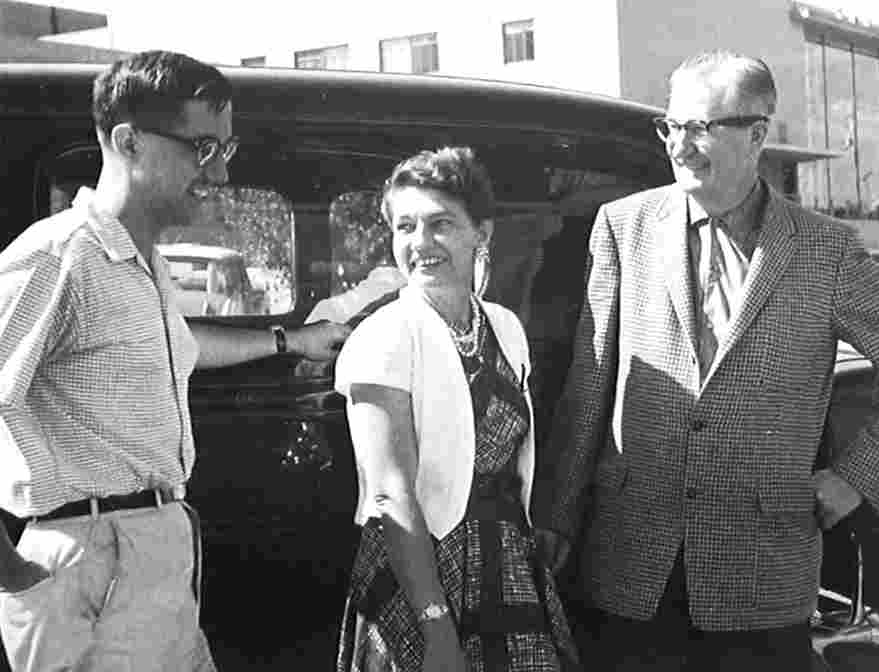
Malcolm, Garé, and Carl outside the Seattle University in 1961.
They stand in front of Malcolm's beloved 1932 V-12 Cadillac Sedan
MALCOLM WILLITS
Malcolm Willits (1934-2019) was a collector of antique cars, original art, pulp magazines, movie memorabilia, and old comic books. The latter were partly traded from his famous Collector's Bookstore in Hollywood, California. Willits had a special affinity for all Carl Barks' artwork, and they were friends for many years.
|
I have long been a Carl Barks fan, ever since the summer of 1943 when I was 9 years old and my older brother condescendingly told me of a new comic book at the drugstore, which featured Donald Duck in ancient Egypt. Since at the time I equated my brother's veracity and interests in my welfare with that of Adolf Hitler's, I professed not to believe him. But when he wasn't looking I ran up to the drugstore and there it was, a big, beautiful comic book entitled Donald Duck and the Mummy's Ring, with lavish drawings of mummy cases, temples, sailing vessels - all the paraphernalia of an ancient world. Carl Barks had hit a responsive chord within me and even though I did not know his name, I was a confirmed fan of his from that day forward.
Being a subscriber to Walt Disney's
Comics and Stories for several years, I had seen and
appreciated Carl's Donald Duck short stories beginning with the
April, 1943, issue. But they did not completely tower over the
other fine work being done those days in Looney Tunes,
New Funnies, and Fairy Tale Parade. And I had somehow
missed the 1942 Four Color comics #9, Donald Duck finds Pirate
Gold. But even its art and story seem a trifle more ordinary
than the magnificent drawings and thrill for adventure as
evidenced within the pages of the Mummy's Ring. Just as one tends to take the continued existence of God for granted, so I continued to take for granted each month's fine Donald Duck short story, and at least once a year a great feature-length story in a special comic book. And if I was sharp and hung around a Portland, Oregon Firestone store each December, I could perhaps con a sympathetic clerk out of a free copy of the Cartl Barks Christmas comic giveaway.
1950 was a traumatic year for me with
the outbreak of the Korean War and the fact that at 16 I'd soon be
cannon-bait unless I started opening my high-school textbooks as
often as I opened my Donald Duck comics.
With peace well-established by 1957 I
felt it time to heed my country's call to arms. After basic
training and undergoing Donald Duck withdrawal tremens I was sent
to Fort Benjamin Harrison outside Indianapolis to the Adjutant
General's school. The Army felt it necessary to make me a
high-ranking officer's secretary, so I was temporarily relegated
to a small office which handled reservists taking Army
correspondence courses. Typically, there wasn't much to do, so one
day I decided to realize a long-standing desire to write the
famous Good Artist of the Donald Duck stories. A short time later the Disney studio replied with the name and address of the Good Artist, and the name of Carl Barks was finally revealed to his myriad of fans. But by this time I was editing the new Army Corps newspaper, and this coupled with my extremely small military pay, I did not write Carl Barks at that time.
In fact it was almost 2˝ years before
I made use of the information, and even then I did not use it to
write Mr. Barks directly. I was out of the Army and was just
completing my first year of high school teaching in a small town
in Washington. For some time I'd been in correspondence with a
young man in Aptos, California, named John Spicer (his brother,
Bill Spicer, later became active in comic fandom).
So on April 11, 1960, John Spicer wrote the first fan letter ever
to breach the KK/Western blocade and reach Mr. Barks directly.
When John informed me of his success, even to the extent of
receiving a reply, this galvanized me into action. So on May 25,
1960, I wrote Mr. Barks myself, thus being the second fan to write
him. Mr. Barks chose to acknowledge his two newfound fans with the June, 1961, issue of Walt Disney's Comics and Stories in a story entitled Stranger than Fiction. I had already informed him of my abiding interest in science fiction, and how much I wished he'd do more stories with this theme.
My visit to Mr. Barks and his artist
wife Garé in early June of 1960 proved to be his second visit from
a fan. The Barkses graciously returned my visit in July of 1961
when they visited me in Seattle while I was attending the
University of Washington. And when I again visited them in 1963 I
took along a tape recorder and undertook the first interview ever
made with him. It is a source of pleasure for me to know that while I may have been the first to ascertain the name of Carl Barks, it was inevitable that his name someday would emerge from the shadows of the Disney organization to stand in its own right as one of the finest popular artists and storytellers of the 20th Century. And an added pleasure to know that he has lived to see tremendous honor and recognition given him for the years he spent placidly sitting at his drawing board spinning tales which brought delight to countless fans around the world. |

http://www.cbarks.dk/themeetingswillits.htm |
Date 2019-10-20 |